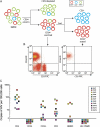HIV-1 DNA is detected in bone marrow populations containing CD4+ T cells but is not found in purified CD34+ hematopoietic progenitor cells in most patients on antiretroviral therapy
- PMID: 22275402
- PMCID: PMC3282572
- DOI: 10.1093/infdis/jir884
HIV-1 DNA is detected in bone marrow populations containing CD4+ T cells but is not found in purified CD34+ hematopoietic progenitor cells in most patients on antiretroviral therapy
Abstract
Identifying cellular reservoirs of human immunodeficiency virus type 1 (HIV-1) in patients on antiretroviral therapy (ART) is critical to finding a cure for HIV-1. In addition to resting CD4(+) T cells, CD34(+) hematopoietic progenitor cells have been proposed as another reservoir. We obtained bone marrow aspirates from 11 patients on ART who had undetectable plasma HIV-1 RNA. HIV-1 DNA was detected in CD4(+) T cells from peripheral blood in all patients and from bone marrow cellular fractions containing T cells in most patients. We did not find HIV-1 DNA in highly purified CD34(+) populations using either a sensitive real-time polymerase chain reaction assay or a coculture assay for replication-competent HIV-1.
Figures

Similar articles
-
Hematopoietic precursor cells isolated from patients on long-term suppressive HIV therapy did not contain HIV-1 DNA.J Infect Dis. 2012 Jul 1;206(1):28-34. doi: 10.1093/infdis/jis301. Epub 2012 Apr 25. J Infect Dis. 2012. PMID: 22536001 Free PMC article.
-
CD34+ progenitor cells from asymptomatic patients are not a major reservoir for human immunodeficiency virus-1.Blood. 1995 Sep 1;86(5):1749-56. Blood. 1995. PMID: 7544640
-
CD34+ hematopoietic progenitor cells are not a major reservoir of the human immunodeficiency virus.Blood. 1990 Oct 1;76(7):1281-6. Blood. 1990. PMID: 1698476
-
Hematopoietic stem/precursor cells as HIV reservoirs.Curr Opin HIV AIDS. 2011 Jan;6(1):43-8. doi: 10.1097/COH.0b013e32834086b3. Curr Opin HIV AIDS. 2011. PMID: 21242893 Free PMC article. Review.
-
Effect of human immunodeficiency virus infection on haematopoiesis.Baillieres Clin Haematol. 1995 Mar;8(1):113-30. doi: 10.1016/s0950-3536(05)80234-3. Baillieres Clin Haematol. 1995. PMID: 7545035 Review.
Cited by
-
Experimental Treatment of SIV-Infected Macaques via Autograft of CCR5-Disrupted Hematopoietic Stem and Progenitor Cells.Mol Ther Methods Clin Dev. 2020 Mar 13;17:520-531. doi: 10.1016/j.omtm.2020.03.004. eCollection 2020 Jun 12. Mol Ther Methods Clin Dev. 2020. PMID: 32258215 Free PMC article.
-
From reactivation of latent HIV-1 to elimination of the latent reservoir: the presence of multiple barriers to viral eradication.Bioessays. 2013 Jun;35(6):544-52. doi: 10.1002/bies.201200170. Epub 2013 Apr 24. Bioessays. 2013. PMID: 23613347 Free PMC article. Review.
-
Eradicating HIV-1 infection: seeking to clear a persistent pathogen.Nat Rev Microbiol. 2014 Nov;12(11):750-64. doi: 10.1038/nrmicro3352. Nat Rev Microbiol. 2014. PMID: 25402363 Free PMC article. Review.
-
Latent HIV-1 infection occurs in multiple subsets of hematopoietic progenitor cells and is reversed by NF-κB activation.J Virol. 2012 Sep;86(17):9337-50. doi: 10.1128/JVI.00895-12. Epub 2012 Jun 20. J Virol. 2012. PMID: 22718820 Free PMC article.
-
Targeted DNA mutagenesis for the cure of chronic viral infections.J Virol. 2012 Sep;86(17):8920-36. doi: 10.1128/JVI.00052-12. Epub 2012 Jun 20. J Virol. 2012. PMID: 22718830 Free PMC article. Review.
References
-
- Haggerty CM, Pitt E, Siliciano RF. The latent reservoir for HIV-1 in resting CD4+ T cells and other viral reservoirs during chronic infection: insights from treatment and treatment-interruption trials. Curr Opin HIV AIDS. 2006;1:62–8. - PubMed
-
- Siliciano JD, Kajdas J, Finzi D, et al. Long-term follow-up studies confirm the stability of the latent reservoir for HIV-1 in resting CD4+ T cells. Nat Med. 2003;9:727–8. - PubMed
-
- Ruiz ME, Cicala C, Arthos J, et al. Peripheral blood-derived CD34+ progenitor cells: CXC chemokine receptor 4 and CC chemokine receptor 5 expression and infection by HIV. J Immun. 1998;161:4169–76. - PubMed
Publication types
MeSH terms
Substances
Grants and funding
LinkOut - more resources
Full Text Sources
Other Literature Sources
Medical
Research Materials

